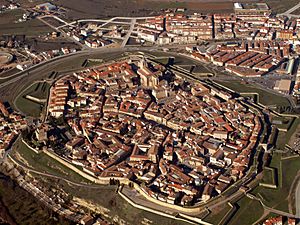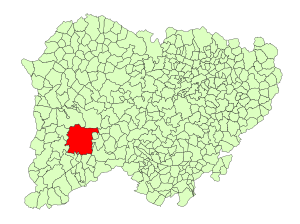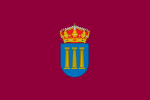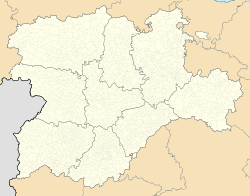Ciudad Rodrigo facts for kids
Quick facts for kids
Ciudad Rodrigo
|
|||
|---|---|---|---|
|
municipality
|
|||
 |
|||
|
|||

Location in Salamanca
|
|||
| Country | |||
| Autonomous community | |||
| Province | Salamanca | ||
| Comarca | Comarca of Ciudad Rodrigo | ||
| Area | |||
| • Total | 240 km2 (90 sq mi) | ||
| Elevation | 658 m (2,159 ft) | ||
| Population
(2018)
|
|||
| • Total | 12,513 | ||
| • Density | 52.1/km2 (135.0/sq mi) | ||
| Time zone | UTC+1 (CET) | ||
| • Summer (DST) | UTC+2 (CEST) | ||
| Postal code |
37500
|
||
Ciudad Rodrigo is a historic city in western Spain. It is located in the province of Salamanca. In 2018, about 12,500 people lived there. The city sits on a rocky hill next to the Águeda River.
People have lived in this area since the Neolithic Age, which was a very long time ago. Ciudad Rodrigo was once an important border fortress. It played a big role in history, especially during the Napoleonic Wars. The famous Duke of Wellington led a major battle here.
Contents
Exploring Ciudad Rodrigo's Location
Ciudad Rodrigo is found on the right side of the Águeda River. It is about 89 kilometers (55 miles) southwest of Salamanca. The city is also close to the border with Portugal, only 25 kilometers (15 miles) away.
A major road, the A-62, connects Ciudad Rodrigo to other Spanish cities like Valladolid and Burgos. It also links the city to Portugal.
Weather in Ciudad Rodrigo
The city is about 658 meters (2,159 feet) above sea level. Ciudad Rodrigo has a Mediterranean climate. This means it has cool and wet winters. The summers are warm and dry. Nights in summer can be quite cool.
| Climate data for Ciudad Rodrigo, Spain | |||||||||||||
|---|---|---|---|---|---|---|---|---|---|---|---|---|---|
| Month | Jan | Feb | Mar | Apr | May | Jun | Jul | Aug | Sep | Oct | Nov | Dec | Year |
| Mean daily maximum °C (°F) | 9.6 (49.3) |
11.9 (53.4) |
15.4 (59.7) |
16.6 (61.9) |
20.6 (69.1) |
26.6 (79.9) |
30.5 (86.9) |
30.3 (86.5) |
26.0 (78.8) |
19.2 (66.6) |
13.4 (56.1) |
10.0 (50.0) |
19.2 (66.5) |
| Daily mean °C (°F) | 4.9 (40.8) |
6.3 (43.3) |
9.1 (48.4) |
10.5 (50.9) |
14.0 (57.2) |
18.8 (65.8) |
21.9 (71.4) |
21.8 (71.2) |
18.4 (65.1) |
13.3 (55.9) |
8.4 (47.1) |
5.7 (42.3) |
12.8 (55.0) |
| Mean daily minimum °C (°F) | 0.1 (32.2) |
0.7 (33.3) |
2.7 (36.9) |
4.4 (39.9) |
7.3 (45.1) |
11.0 (51.8) |
13.2 (55.8) |
13.2 (55.8) |
10.8 (51.4) |
7.4 (45.3) |
3.4 (38.1) |
1.3 (34.3) |
6.3 (43.3) |
| Average rainfall mm (inches) | 42.9 (1.69) |
32.3 (1.27) |
27.7 (1.09) |
42.6 (1.68) |
53.7 (2.11) |
19.7 (0.78) |
10.0 (0.39) |
11.9 (0.47) |
32.8 (1.29) |
64.2 (2.53) |
61.3 (2.41) |
56.1 (2.21) |
455.2 (17.92) |
| Source: World Meteorological Organization | |||||||||||||
A Look Back at Ciudad Rodrigo's History
Early Beginnings
Ciudad Rodrigo was first a Celtic village called Mirobriga. Later, the Romans took over the area. They renamed the town Augustobriga.
In the 12th century, King Ferdinand II of León helped the city grow again. He had walls built around it. He also brought back the old church leadership, creating a new bishopric. This led to the building of the city's beautiful cathedral. It mixes Gothic and Romanesque styles.
Famous Artworks
In the 15th century, a large artwork called the Retablo was made for the Cathedral. It had about 35 painted panels. Artists like Fernando Gallego worked on it. Over time, the paintings got old and damaged.
In 1954, the Samuel H. Kress Foundation bought them. They had the artworks carefully fixed. In 1961, the foundation gave them to the University of Arizona Museum of Art. You can see them there today.
The Napoleonic Wars and the Sieges
Ciudad Rodrigo was very important during the Napoleonic Wars. It was a strong, walled town on the main road from Portugal to Salamanca.
In 1810, French Marshal Michel Ney attacked the city. The Spanish soldiers defended it bravely for 24 days. But the French broke through the walls. The Spanish had to surrender. This battle delayed the French invasion of Portugal.
Two years later, in 1812, the British General Wellington attacked Ciudad Rodrigo. His army took the city in just 10 days. They opened two large holes in the walls. British soldiers then rushed in. This victory was important for Wellington. It allowed him to continue his campaign.
After this win, Wellington was given a special Spanish title. He became the Duque de Ciudad Rodrigo.
The city is also the birthplace of Siglo de Oro writer Feliciano de Silva.
What to See in Ciudad Rodrigo
The old part of Ciudad Rodrigo is surrounded by its historic city walls.
- The City Walls: These walls were first built in the 12th century. In the 17th century, they were made even stronger. They added bastions and places for cannons.
- The Cathedral of Santa María: This is a medieval cathedral. It was built in the 12th century. It has many beautiful artworks inside. These include the main entrance (Portico del Perdón) and old wooden choir stalls.
- Old Mansions: You can find many old, well-kept houses and palaces. They show off Renaissance and Baroque styles.
- Castro's Palace: Known for its impressive front.
- The Palace of Moctezuma: Once home to dukes, it is now a cultural center.
- Palace of the Aguila: This palace has a garden and two courtyards.
- Henry II's Castle: This castle was built in the 14th century. It sits on a hill overlooking the Águeda River. Today, it is a Parador, which is a type of hotel in a historic building.
- Plaza Mayor: This is the main town square. Important buildings around it include the 16th-century city hall.
- Chapel of Cerralbo: Another historic building to visit.
The Castle of Henry II of Castile
King Enrique II of Castile built this castle in 1372. It is a strong and historic building. Today, it serves as a hotel, allowing visitors to stay inside a piece of history.
International Connections
Ciudad Rodrigo has a special connection with another city. It is twinned with:
 – Aveiro, Portugal
– Aveiro, Portugal
Images for kids
-
The City Walls, built by Ferdinand II of León in the 12th century.
See also
 In Spanish: Ciudad Rodrigo para niños
In Spanish: Ciudad Rodrigo para niños





















